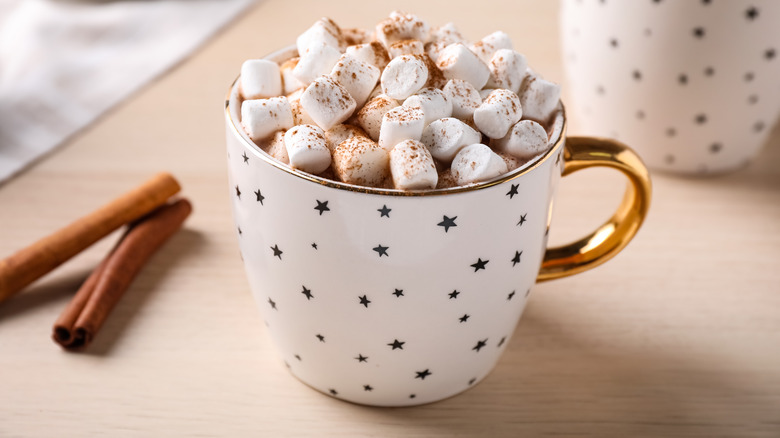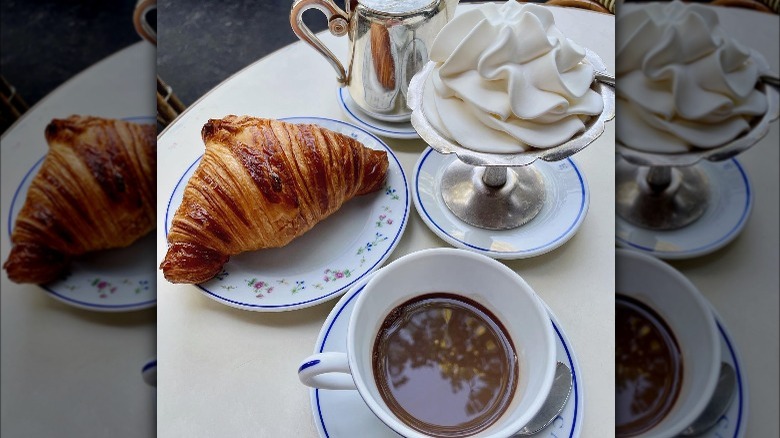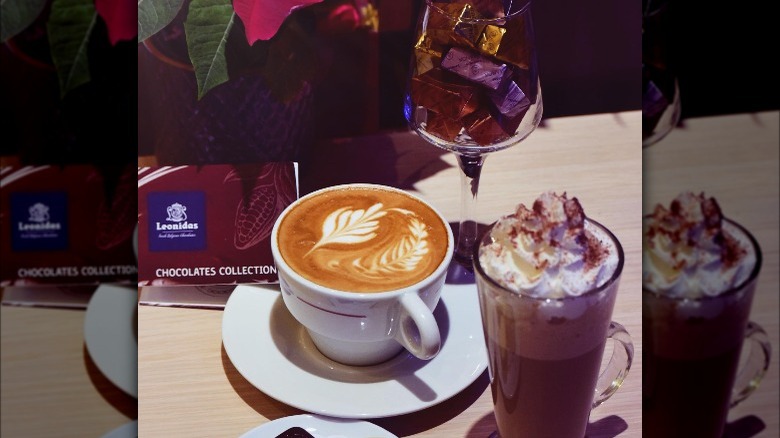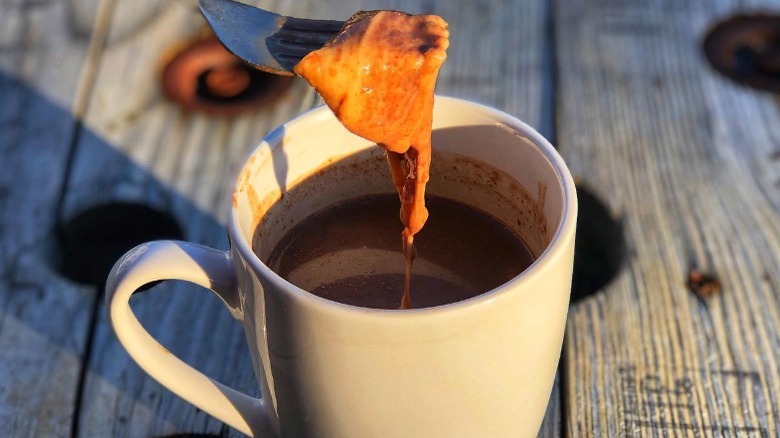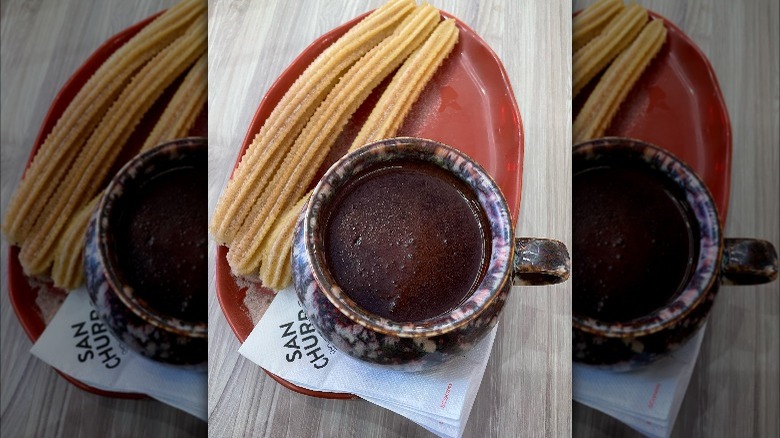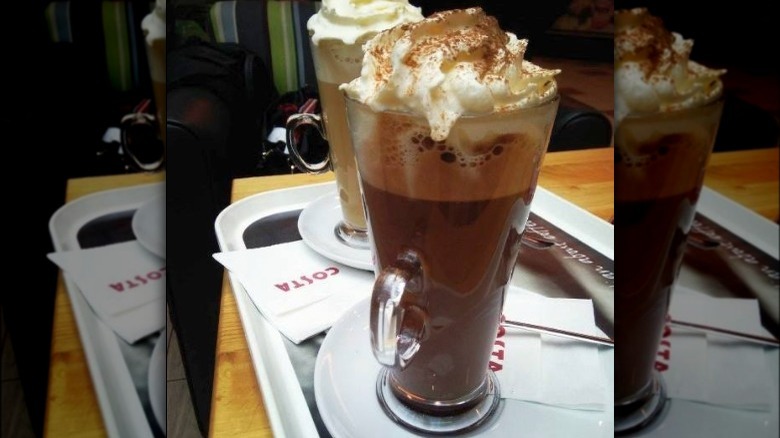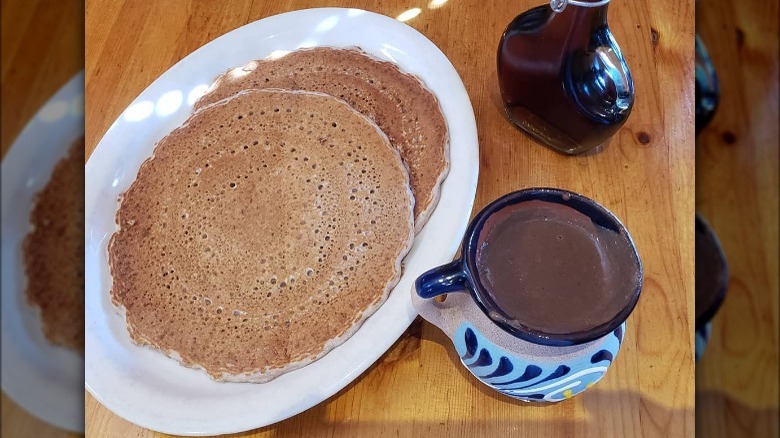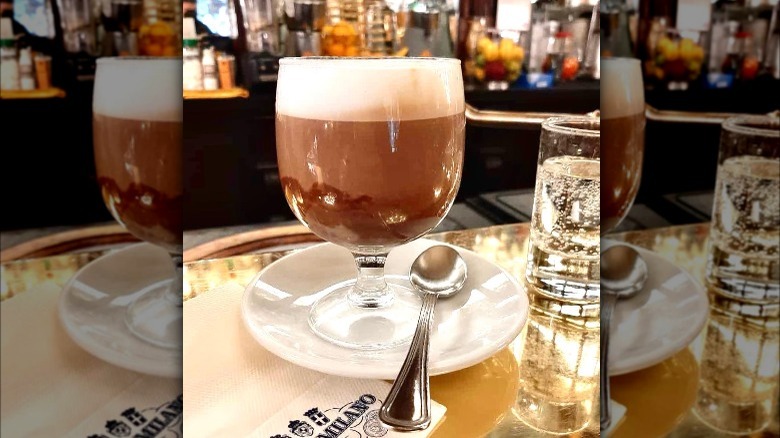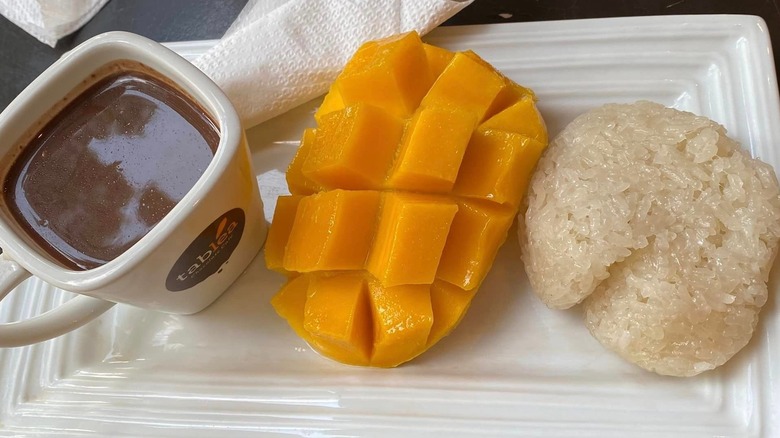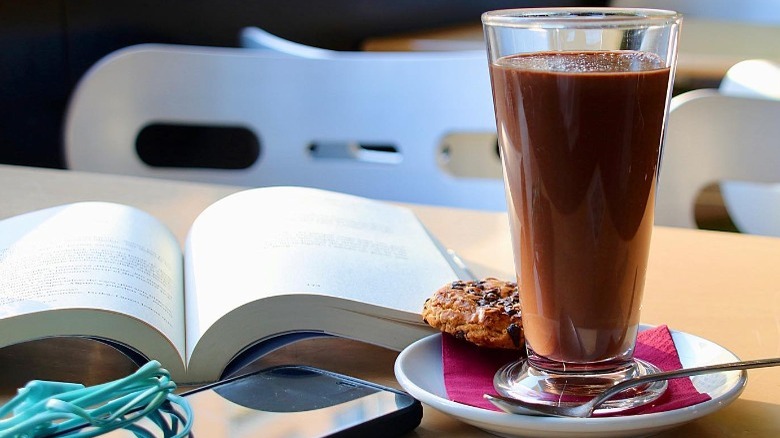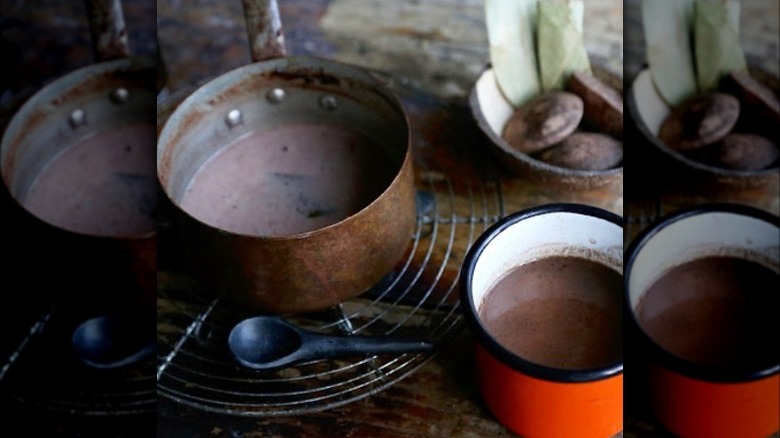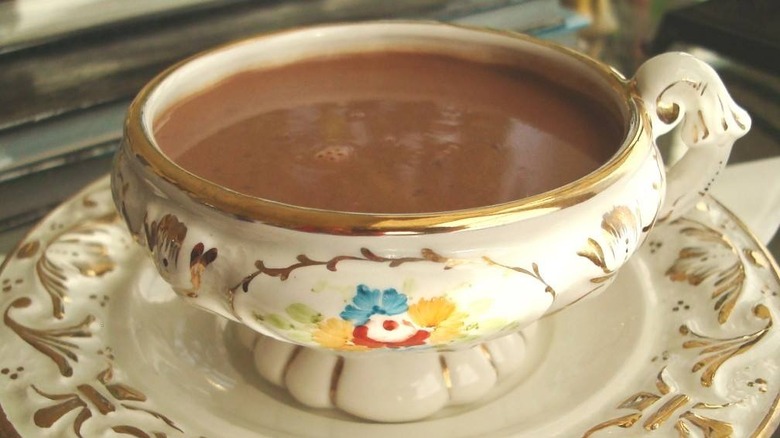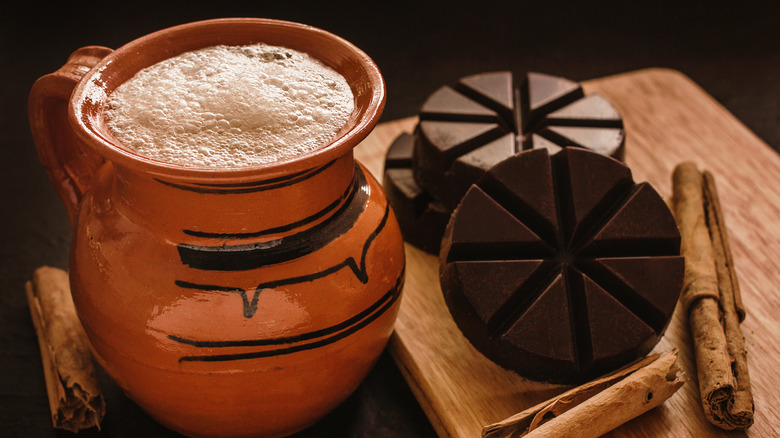How People Around The World Drink Hot Chocolate
Hot chocolate is hot chocolate, right? One study shows that the majority of Americans, around 62%, prefer their drink traditional. But what makes it traditional? In North America, it typically means that the hot chocolate is made using steamed milk with cocoa powder and then topped with marshmallows to seal the deal. For a lot of us, there's simply no other way to drink hot cocoa. In fact, Smithsonian Magazine points to hot chocolate and marshmallows as being a distinctly American tradition.
Although marshmallows are a candy as old as time, quite literally drawing lineage back to Ancient Egypt, the modern marshmallow was first created in 19th-century France. The American iteration came to be more or less in the 20th century, and the leading marshmallow manufacturer sought to add marshmallows to as many recipes as possible. While some of the more eccentric combinations like a mayo-marshmallow-lettuce salad faded into obscurity, the wonderfully enriching ooey-gooeyness of a hot chocolate bedecked with marshmallows stays as an American hallmark to this day.
But it may come as a surprise to learn that there's a world of possibility out there when it comes to the beloved winter drink. Just as you can find a variety of hot chocolate variations stateside like water versus milk or marshmallows versus whipped cream, there are many ways different cultures serve this time-honored drink. Read below to discover different ways hot chocolate is sipped around the world.
Chocolat chaud
When it comes to food, France is a good place to turn to. Le chocolat chaud is similar to American hot cocoa, but there are key differences. As noted by The Athenaeum, hot cocoa is prepared with cocoa powder mixed with milk and it tends to be very chocolatey in flavor and sweet. On the other hand, chocolat chaud is made from chocolate shavings, milk, cream, and sugar. It is an extremely creamy, rich, and filling drink.
One writer from the Los Angeles Times went so far as to say that when he's in Paris in the winter, it's not warming winter wines or great cafés that he seeks out, but rather chocolat chaud. He sings the praises of the French take on the drink and notes that the chocolate shavings used for it are typically 70% cacao or more. The chocolate, he reports, is usually sourced from Africa or South America, two major and wonderfully delicious regions for chocolate. Chocolat chaud so rich that it is usually served with a glass of water on the side to give the palate a cleanse every once in a while. He also notes that if you are searching for a truly elevated chocolat chaud experience, it shouldn't be hard to find the right venue in Paris; there are plenty of upscale cafés to sip chocolat chaud from a porcelain cup. When in Rome, right?
Viennese hot chocolate
Vienna is a city with a rich coffee house culture, so it should come as no surprise that the city would have a refined take on a classic hot chocolate drink. For a very long time, hot chocolate was something that only aristocrats could afford. It would be served in the morning laden with vanilla and cinnamon, according to The World of Habsburgs. To really emphasize the decadence, the Viennese created refined serving sets to enjoy their hot chocolate in, sort of how tea service sets still exist to this day (via Smithsonian Magazine). In some circles, it was not uncommon for these hot chocolate sets to be made out of porcelain and gold. Similar to the French, the Viennese served the drink with a refreshing glass of water.
According to the World of Habsburgs, by around the 18th century, hot chocolate had trickled down from aristocratic circles to coffee houses. It was here, still in an elegant setting, that anyone who had the spare money could indulge in what came to be referred to as a hot chocolate Viennois. While the Viennese aristocracy did not stand the test of time, the drink certainly did. Nowadays, visitors can still go to coffee houses and enjoy a warm cup of hot chocolate. Café Schwarzenberg still offers up a cup, as one review observes, chock-full of vanilla and cinnamon just as it was traditionally made.
Chocolate santafereño
Cacao and hot chocolate have a long history in Latin America. After all, this is the region where it originated (via World History Encyclopedia). With that in mind, there is a good reason to not knock the Colombian chocolate santafereño before you try it. Instead of serving up their hot chocolate with marshmallows to get that ooey-gooey melt-in-your-mouth bliss, Colombians opt for a chunk of savory cheese to get the intended effect.
Similar to French and Austrian hot chocolates, Colombian hot chocolate is made from melted blocks of chocolate, according to Atlas Obscura. This chocolate is, however, traditionally very sweet and seasoned with both clove and cinnamon. The chocolate is melted and whisked in such a way that it becomes extremely foamy, similar to the frothy cups of drinking chocolate from ancient Mesoamerican civilizations (via World History Encyclopedia).
Once made, a salty white cheese by the name of queso campesino is dolloped into the cup and then the hot chocolate is served, usually accompanied by cheesy bread, according to Atlas Obscura. The cheesiness of the Colombian hot chocolate experience is rarely found anywhere else, but there is good reasoning behind the method. After all, does the salty cheese not serve as a break from the sweetness of the chocolate? Either way, for those with an open mind, perhaps open your mouth to this South American delicacy.
Spanish hot chocolate and churros
In the history of hot chocolate, it was the Spanish who were perhaps the most responsible for introducing it to the European continent. After Cortés and his men reached South America, they quickly learned of the importance of drinking chocolate to Meso- and South American empires and recognized the potential it had abroad.
Because of this, it comes as no surprise that drinking chocolate is popular nowadays on the Iberian peninsula. Chocolate beverages were originally left unsweetened in the Americas, and Spanish monks were among the first to sweeten up the once-bitter drink. As centuries have passed, the popularity of hot chocolate in Spain has persisted. While it was once a drink only available to the likes of kings, now it's common for children to enjoy a cup of chocolate with breakfast.
Spanish hot chocolate remains decidedly thicker than other iterations of the drink. The Spanish prefer to pair their hot chocolate with a little snack. They tend to serve their hot chocolate with churros. The drink is so thick that it's used as a sauce to dip the fried-dough sticks in (via Salt and Wind). It's not the breakfast of champions, but it may be the breakfast of hedonists. And for some, that's exactly as breakfast should be, at least once in a while.
Forró Csokoládé
Hungarian hot chocolate may seem obscure, but it is worth getting to know. The Daily Hungary observes that hot cocoa is the easiest (and most cost-effective) way to warm up a cold weekend and maximize coziness. The news site suggests that the easiest way to make cocoa is to add some sugared cocoa powder to milk and heat it up in the microwave.
But the country offers up some different ways to enjoy the drink at a more elevated level. Hungarian hot chocolate, known as forró csokoládé, can be a really intense experience. Hungarian hot chocolate combines dark cocoa powder with heavy cream, sea salt, and uniquely Hungarian paprika.
For those who may be unfamiliar, paprika is widely grown in Hungary and is commonly used in Hungarian cuisine (via The Hungarian Paprika). Apparently, this extends even to sweet drinks. Similar to cinnamon, paprika adds a slight edge to the drink and deeper nuance of smoke and savoriness. It's a drink that warms and fills in an unexpected way. To sweeten the pot, in All Spice Emporium's mix they add a few mini chocolate chips to deepen the chocolate flavor. For those looking for something a bit more interesting than the typical weekend hot chocolate, look no further.
Pinole
Pinole is truly in a class of its own. In 2016, the Food Network described the ancient drink as a superfood with the potential to become the next big thing. Around six years later, the drink remains, at least in the U.S., relatively obscure. But for those who would like to include cacao in their health-oriented diet, it's time to get to know this drink.
Cacao is just one part of this drink that owes its origins to the Mexican region, per Imbibe Magazine. The drink combines blue and purple maize, or corn, that's then roasted and combined with raw cacao. The Food Network notes that the texture of this drink is closer to oatmeal or grits than it is to a traditional cup of cocoa. It's also not as sweet as other chocolatey drinks.
While this may not sound completely appealing, for those looking to reap all of the healthful benefits of cacao this is the perfect hot chocolate for them. The original ultra-runners, the Tarahumara, drink pinole before embarking on their legendary 100-mile runs. Even if you aren't embarking on those 100-mile journeys, pinole can still be a wonderful source of antioxidants, vitamins, and minerals.
Cioccolata calda
Leave it to the Italians to make a truly beautiful cup of hot chocolate. Italy Explained notes that even though coffee is practically worshiped in Italy, their cioccolata calda is just as holy. The sweet drink can even be ordered as a stand-alone dessert in its own right. Often the drink is so thick that you may even need a spoon to enjoy it. Its unique thickness doesn't come from the amount of chocolate used, as Italy Magazine clarifies, but rather because of the thickening agent used in the recipe. Typically, flour or cornstarch is used to get the drink to the appropriate amount of thickness. Rather than a beverage, it might be better to describe this confection as hot pudding.
Cioccolata calda is a much richer, and at times less sweet, experience than much of the hot chocolate in the United States. When enjoying, Italy Magazine gives just one piece of advice for the indulgent experience: sip slowly. Cioccolata calda is often served extremely hot.
Sikwate
As CNN notes, it may come as a surprise to be served up a mug of cocoa in the tropical heat of the Philippines. But if you're ever given the opportunity to indulge in a cup of sikwate, you absolutely should. CNN credits chocolate's introduction to the Philippines to the Spanish colonial rule that lasted some 300 years. It isn't uncommon for Filipino families to have a cacao tree. Because cacao trees can be cultivated so easily there, it has allowed for a wide variety of chocolate recipes and experimentation.
There's not one way to make sikwate, but there is a general consensus: The drinking chocolate is always made from tablea, which are blocks of compressed, dried, and fermented cacao beans. This gives the drink a really rich and undeniably bold cacao flavor. As described by Eat Your World, it's as if you're drinking a cup of raw chocolate.
From there, there are innumerable variations to make: Some dilute the tablea with milk, others with water, sometimes hot, sometimes cold. Some are sweetened with sugar or thickened with milk. Wherever you are, sikwate can take many different forms. In general, rather than being thick like Spanish hot chocolate, sikwate is whisked until it's rather foamy. Eat Your World recommends either pairing the drink with fresh mango or sweet, sticky rice cakes to have the full experience.
El submarino
It doesn't take a wordsmith to deduce that the Argentinian "el submarino" translates back to submarine, which perhaps isn't the imagery that you would usually associate with hot chocolate. Nonetheless, with a little bit of context, it all makes sense. As Taste Atlas outlines, el submarino is all about the method: A thick piece of dark chocolate is submerged into a steaming cup of milk, and the more the drink is stirred, the more chocolatey it becomes.
Perhaps it's an exaggeration to call this a reinvention of hot chocolate, but there is certainly something unique and charming to this drink. As noted by The Culture Trip, Argentinian chocolate culture is the result of a mix of different traditions. Because European immigration to the country increased after the Second World War, a lot of European chocolate customs came to the region. One could argue that there is a cultural fusion between South American and European hot chocolate going into Argentine cups. Unlike other hot chocolate drinks around the world, el submarino comes unsweetened and needs to have additional sugar dunked in to make sure it's properly sweet.
Chocolate tea
Caribbean chocolate tea is a beloved and long-held hot chocolate tradition (via Atlas Obscura). Despite the name, according to the St. Lucia Loop News, the drink is oatmeal-like in consistency. The chocolate drink is brewed from fermented cacao beans which have been ground and pressed into a ball- or stick-like form. These cacao balls are grated into a powder, then boiled in a water and milk mixture.
This drinking chocolate leans heavily into spices: nutmeg, cinnamon, clove, and even bay leaf can be found bringing life into this drink. Condensed (or sometimes coconut) milk is added to sweeten the pot, quite literally. Leave it to the Caribbean to elevate hot chocolate to an extremely flavorful and well-rounded drink. According to Atlas Obscura, the concoction's true secret to greatness is the cacao that's used. It's minimally processed, which gives the drink a distinct sharpness to it that other hot chocolate simply does not have. In some cases, hot chocolate can even be a meal, and cooks in St. Lucia often opt to float flour dumplings in chocolate tea and serve it for breakfast.
Peruvian hot chocolate
While hot chocolate might be an unofficial holiday delight in the States, in Peru it is specifically a Christmas Eve tradition. This is surprising given that Christmas is the hottest time of the year in South America. While it's unclear how this Christmas hot chocolate came to be, there is consensus that with the Christmas hot chocolate comes the Italian Christmas cake: panettone (via The Day).
The tie-in between Italian seasonal cake and Peruvian Christmas traditions is a bit clearer than the origin of the hot chocolate tradition. After massive immigration from Italy to Peru in the late 19th and early 20th centuries, many Italian foods were absorbed into Peruvian cuisine.
But how exactly is this Peruvian hot chocolate prepared? Traditionally the hot chocolate incorporates milk that's been spiced with clove and cinnamon. Grated chocolate is then added and stirred in. The drink isn't necessarily sweet on its own, and sugar is added afterward to sweeten the drink up (via The Day). While this touch isn't universal, the cook interviewed in the aforementioned article adds butter to get her chocolate to the desired creaminess.
Mexican hot chocolate
Chocolate and Mexico go together hand-in-hand. As noted by The Culture Trip, ancient Mesoamericans were the first to cultivate cacao, and they're who we have to thank as we drink our cups of hot chocolate today. Of course, drinking chocolate has changed a lot since it was first cultivated, but it still remains beloved in Mesoamerica and contemporary Mexico.
Mexican hot chocolate remains extremely important to the national cuisine. It can usually be found in the form of chocolate bars that are melted down to make a uniquely grainy hot chocolate. It is still served up frothy just as it was in ancient times (via World History Encyclopedia).
The Latin America Food Navigator ascribes a few other unique properties to Mexican hot chocolate. It notes that Mexican cacao tends to have a more floral flavor. This is a hot chocolate that simply tastes different. While originally vanilla was used to season the drink, nowadays, Mexican hot chocolate features cinnamon, which points to a direct Spanish influence. It's evident that Mexican hot chocolate exists at the crossroads of history, geography, and culture.
